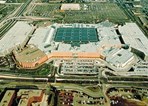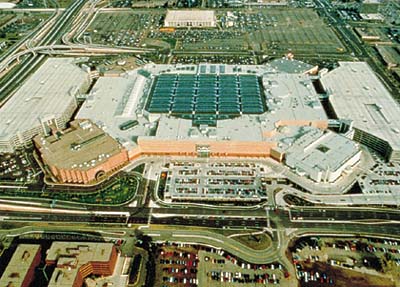Sidestep Coverage Problems With Repeaters

Buildings such as two-story shopping centers and high-rise office towers can create coverage nightmares. Repeaters provide one solution for taking care of them.
By David Bolan, Repeater Technologies
Mining Minutes Inside America's Largest Mall
Blanketing the Vancouver Mall
Gaining That Extra 10%
Keep a Watchful Eye
"The cellular user you're trying to reach is outside the calling area..."
Everyone's heard that recording, but chances are the target user isn't outside of the calling area; he could just as easily be inside a building. This is why carriers such as U S West Wireless are drilling into concrete and steel to mine those lost minutes. From malls to high-rise office towers, the carrier uses repeaters to supplement coverage where necessary in its CDMA network deployments (see Figure 1).

Figure 1: Shopping centers and malls, such as The Mall of America, can be a minefield for wireless calls.
The decision to deploy repeaters started at the top—literally. The executive board room at U S West headquarters in Denver, CO, stands 52 floors above the prairie, which puts it about 500 feet above the neighboring cell-site antennas. With the nearby cell site's down-tilted antennas, the only signals that reached the penthouse power elite were rogue radio waves from various, distant sites. Having no dominant pilot or control signal was wreaking havoc with calls. The carrier decided to boost its nearest signal—50 stories up—with an OA1900NR CDMA repeater from Repeater Technologies (RTI).
"We mounted a single over-the-air repeater on the roof with its antenna down-tilted toward a donor site located about a quarter mile away," said John Keating, director of network operations for U S West Wireless. "The repeater was fed to a distributed antenna system made up of coax cable and six, 4-inch square antennas mounted inconspicuously in various places on the 52nd floor. The result was no more pilot pollution; no more dropped calls."
Mining Minutes Inside America's Largest Mall (Back to Top)
Shopping centers and malls provide another growing in-building-repeater application for U S West Wireless. To that end, the carrier has enhanced coverage in several major shopping centers around the country, including The Mall of America in Minneapolis, MN. The mall is the nation's largest retail and entertainment complex, and it is a landmark that's getting blanket coverage. The 4.2-million-square-foot facility, which is large enough to hold 32 Boeing 747s, attracts nearly a million shoppers a month during peak seasons, and U S West Wireless was banking that foot traffic would translate into call traffic.
The initial objective was to cover the interior of the mall. U S West Wireless handled this by mounting a three-sector array of antennas on one of the floor-to-ceiling pillars at the center of the amusement park located inside the mall. The solution solved the in-building coverage problem, said project RF engineer Scott Schecklman. The team located the base station on the roof and ran 200 feet of coax to the antennas.
However, callers beyond the reach of the core coverage—those deep inside the four anchor department stores at the corners of the mall and those walking to their cars—were generating a large chunk of the wireless phone traffic. To handle the perimeter coverage, Schecklman augmented the core antennas with repeaters mounted in the stairwells leading to the two seven-level parking ramps at the east and west ends of the mall (see Figure 2).

Figure 2: A 3-sector cell site covers the majority of the mall. Two coax-linked repeaters mounted near the parking ramps provide perimeter coverage.
"We ran the alpha sector through a 10dB coupler—tapping off a portion of its signal," Schecklman said. "Then we directed the coupled signal through a two-way splitter and ran coax out to each repeater."
Because the repeaters would be getting a much hotter signal than they would have from an over-the-air signal transmitted from a cell site a mile or two away, the carrier had to attenuate it to keep from over-driving the amplifiers. To do that, the team downsized the cable to 3/8-inch heliax, which loses 5dB per hundred feet. Cable runs of 1,200 feet to the west and 900 feet to the east took it down 60dB and 45dB, respectively. The team then added an additional 5dB and 20dB of attenuation to equalize the loss at 65dB.
Each repeater was linked to two antennas mounted on either side of the skyway, so there was no signal blockage. The repeater antennas were then pointed down and toward the mall.
"The idea is, when the signal hits the wall, some of it will leak into the stairwells and anchor department stores; the rest will reflect off the wall into the parking structure," Schecklman said. "Feeding this call traffic to the under-utilized alpha sector left us pretty balanced in terms of overall traffic loading for the BTS."
After U S West Wireless brought the repeaters on the air, the number of calls processed by the base station doubled almost overnight. Because the repeaters don't serve the nearby highways, that means about half of the call traffic at the Mall of America is at the perimeter of the mall and in the parking ramps.
Blanketing the Vancouver Mall (Back to Top)
For shopping centers that aren't the size of a small European country, a single well-placed repeater can do the trick. In Vancouver, WA, just outside of Portland, U S West Wireless is beaming coverage into a two-story indoor mall using a unit mounted on an existing cell site about 2,000 feet away.
"We realized that we needed to improve the coverage for the mall's shoppers during the Christmas rush last year," said Wayne Wooten, network operations manager. "Using a repeater gave us a quick turnaround on the added footprint."
Eric Wall handled the RF engineering on the site. "He said the team pulled the donor signal from a cell site about a mile and a half away, then focused a narrow, 33° antenna at the mall, taking advantage of the high glass walls of the food court to enhance signal penetration.
Gaining That Extra 10% (Back to Top)
Another repeater implementation covers the exclusive three-level Bellevue Square indoor mall in the Seattle suburbs. Three nearby cell sites were leaking signal into the shopping center, but a small portion of the mall was being shielded. As luck would have it, the U S West Wireless store inside the mall turned out to be smack dab in the middle of the RF shadow.
"With seven carriers competing in the market, one of our overall objectives is to achieve an average of 90% in-building coverage," said RF engineer, Mark Prostor. "Obviously, we needed to go 10% better in this situation." Prostor decided to try a repeater with a Decibel indoor antenna.
"We mounted a small antenna on the roof, a low-noise RTI repeater above the door of our retail store and a ceiling-mounted antenna that threw a long narrow signal down the affected hallways," Prostor said. "The whole process was virtually invisible to the public, and going with a repeater kept us from having to deal with sticky siting issues that have come up with so many players in the market."
Keep a Watchful Eye (Back to Top)
To guard against any unforeseen hiccups in service, the majority of U S West Wireless' repeaters are or will soon be monitored on a 24/7 basis in the company's network operations center (NOC) in Denver using RTI software called RepeaterNet. The carrier currently has five repeaters online and expects to have another eight installed and monitored by the end of the year, said NOC manager Veron Rygh. The repeaters talk to the NOC via POTs lines with the exception of the mountaintop unit at Beaver Creek, CO, which is linked via a PCS connection.
"Any alarms we get are routed into our in-house monitoring software system," Rygh said. "We've asked our engineers to filter out some of the less critical preset alarms in the software because we have to react to so many day-to-day alarms from our cell sites. But once we get the repeaters in place, everything seems to go smoothly. Compared to our base stations, repeaters don't talk very much."
About the Author
David Bolan is vice president of marketing for Repeater Technologies, 1150 Morse Avenue, Sunnyvale, CA 94089-1605; tel: 408-747-1900; fax: 408-747-0375. David can be reached at davidb@repeaters.com or 408-743-9317.
